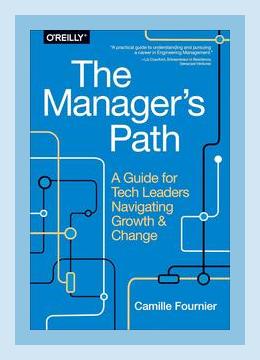Leadership and ManagementOrganizational Behavior
Introduction
Camille Fournier’s “The Manager’s Path: A Guide for Tech Leaders Navigating Growth and Change” (2017) serves as both a roadmap and a practical guide for individuals transitioning into technical leadership roles. The book focuses on the layered complexity of tech management and provides an organized trajectory from being a new manager to becoming a seasoned technical leader. Through concrete examples and specific actions, Fournier offers valuable insights into each stage of the managerial journey.
Chapter 1: Management 101
Major Points:
1. Transition from Engineer to Manager:
– Understand that management is a distinct skill set.
– Realize the significance of soft skills in leadership roles.
Examples & Actions:
– Example: An engineer who once focused solely on coding must now prioritize team dynamics and project management.
– Action: Begin by scheduling one-on-one meetings with each team member to understand their goals and challenges.
Chapter 2: Mentoring and Coaching
Major Points:
1. Role of a Mentor:
– Provide guidance and share experiences.
– Help junior engineers develop their skills.
- Effective Coaching:
- Active listening and asking insightful questions.
Examples & Actions:
– Example: A mentor shares insights on navigating organizational politics.
– Action: Regularly check in with mentees to discuss career progression and provide feedback on their work.
Chapter 3: Training New Managers
Major Points:
1. Setting Expectations:
– Ensure new managers understand their responsibilities.
- Providing Support:
- Offer resources like books, courses, and experienced mentors.
Examples & Actions:
– Example: A company offers workshops on conflict resolution and project management.
– Action: Develop a buddy system where new managers are paired with experienced ones for the first 90 days.
Chapter 4: Managing a Team
Major Points:
1. Building Trust:
– Open communication lines.
- Setting Goals:
- Establish clear, measurable objectives.
Examples & Actions:
– Example: A team leader facilitates an open discussion forum for team concerns.
– Action: Use tools like OKRs (Objectives and Key Results) to set and track team goals.
Chapter 5: Managing Multiple Teams
Major Points:
1. Delegation and Trust:
– Empower team leads.
- Communication:
- Maintain clarity and transparency across teams.
Examples & Actions:
– Example: A manager uses regular inter-team meetings to foster collaboration.
– Action: Create a shared document outlining each team’s objectives and deliverables to ensure alignment.
Chapter 6: Managing Managers
Major Points:
1. Shift in Responsibilities:
– Focus moves from direct team outcome to higher-order strategy.
- Performance Reviews:
- Conduct in-depth reviews of managerial performance.
Examples & Actions:
– Example: A senior manager holds quarterly performance reviews focused on leadership tasks.
– Action: Create a checklist for evaluating managerial effectiveness, covering both team success and individual growth.
Chapter 7: The Senior Leadership Team
Major Points:
1. Strategic Vision:
– Work on long-term goals and organizational health.
- Cross-functional Leadership:
- Lead across various departments.
Examples & Actions:
– Example: Senior leaders develop a 5-year technology roadmap aligning with business objectives.
– Action: Schedule bi-monthly strategic meetings with heads of different departments to ensure alignment.
Chapter 8: Leading at the Senior Level
Major Points:
1. Organizational Culture:
– Shape and embody company culture.
- Decision Making:
- Make high-impact decisions considering company-wide implications.
Examples & Actions:
– Example: A CTO spearheads a cultural initiative focused on diversity and inclusion.
– Action: Implement an anonymous feedback system to gauge cultural health and employee sentiment.
Chapter 9: Career Growth for Senior Leaders
Major Points:
1. Continuous Learning:
– Senior leaders must invest in their development.
- Building External Networks:
- Engage with peer groups outside the organization.
Examples & Actions:
– Example: Executives attend industry conferences to stay abreast of trends.
– Action: Join professional organizations or advisory boards to expand industry knowledge and network.
Chapter 10: How to Stay in Tech
Major Points:
1. Balancing Leadership and Technical Skills:
– Maintain a foothold in technical areas while leading.
- Innovating Within Roles:
- Lead innovation initiatives or special projects.
Examples & Actions:
– Example: A director spends a small percentage of their time in code review or technical discussions.
– Action: Designate one day a month for senior leaders to work directly on a technical project or research.
Epilogue: The Manager’s Path
Major Points:
1. Reflection and Growth:
– Continuously reflect on and adapt leadership style.
- Mentorship Legacy:
- Pass on knowledge and create a culture of continuous learning.
Examples & Actions:
– Example: A retired CTO writes a blog sharing leadership experiences.
– Action: Encourage ongoing learning and development sessions even for senior management, and facilitate mentorship programs for budding leaders.
Conclusion
Camille Fournier’s “The Manager’s Path” is a comprehensive guide for anyone on the managerial path within a technology firm. It goes beyond basic management principles, offering nuanced, actionable insights specifically tailored to the unique challenges faced by technical leaders. From foundational concepts of team management to the complexities of senior leadership, the book serves as a vital resource at every stage of a tech leader’s career. By applying the strategies and examples provided, individuals can effectively navigate growth and change, fostering both personal and organizational success.
